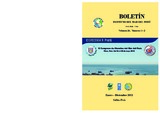Por favor, use este identificador para citar o enlazar este ítem:
https://hdl.handle.net/20.500.12958/2156Registro completo de metadatos
| Campo DC | Valor | Lengua/Idioma |
|---|---|---|
| dc.contributor.author | León, Violeta | |
| dc.contributor.author | Paulmier, Aurelian | |
| dc.contributor.author | Ledesma Rivera, Jesús | |
| dc.contributor.author | Croot, Peter | |
| dc.contributor.author | Graco, Michelle | |
| dc.contributor.author | Flores Gonzáles, Georgina | |
| dc.contributor.author | Morón Antonio, Octavio | |
| dc.contributor.author | Tenorio, José | |
| dc.date.accessioned | 2013-07-05T16:40:10Z | |
| dc.date.available | 2013-07-05T16:40:10Z | |
| dc.date.issued | 2011 | |
| dc.identifier.citation | Bol Inst Mar Perú 26(1-2), 2011: p. 19-24 | es_ES |
| dc.identifier.issn | 0458 - 7766 | |
| dc.identifier.uri | https://hdl.handle.net/20.500.12958/2156 | |
| dc.description | Boletín IMARPE vol. 26, nº 1-2, 2011; p. 19-24 | |
| dc.description.abstract | Se analizó información sobre parámetros biogeoquímicos como pH, CO2 parcialmente disuelto, clorofila-a, oxígeno, salinidad y temperatura, obtenidos en el Sistema de Humboldt frente a Perú en los años 2007-2009, a fin de comprender la importancia del pH como una variable clave para trazar la variabilidad biogeoquímica del Sistema de Afloramiento de Humboldt. Las Aguas Costeras Frías (ACF) ricas en nutrientes evidencian una relación inversa con el pH, en ese sentido valores de 7,6 a 8,0 se encontraron asociados a la ocurrencia de eventos de afloramiento; en condiciones frías como La Niña 2007 el pH predominante se encuentra por debajo de 8,0, y en el caso de las Aguas Subtropicales Superficiales presentan un pH entorno a 8,3. La productividad en los veranos se incrementa debido a factores como la intensidad de luz generándose núcleos de clorofila-a superiores a 10,0 μg.L-1; como constituyentes de la reacción bioquímica de fotosíntesis se tiene en cuenta la forma inmediata del compuesto CO2 y el consumo de iones hidronio; en situaciones extremas de fertilización, se tiene elevado pH entre 8,2 e inclusive 9,0, en donde los contenidos de oxígeno disuelto superan los 6,0 mL.L-1. | es_ES |
| dc.description.abstract | ABSTRACT: We analyzed information on biogeochemical parameters such as pH, CO2 partially dissolved, chlorophyll-a, oxygen, salinity and temperature, obtained in the Humboldt system off Peru in the years 2007-2009, in order to understand the importance of pH as a variable key to tracing the biogeochemical variability of the Humboldt upwelling System. Cold Coastal Waters (ACF) rich in nutrients show an inverse relationship with pH, in that sense values from 7.6 to 8.0 were associated with the occurrence of upwelling, in cold conditions and La Niña 2007, the pH is predominant below 8.0, and for Subtropical Surface Waters have a pH around 8.3. Productivity in the summer increases due to factors such as light intensity cores generating higher chlorophyll-a to 10.0 µg.L-1, as constituents of the biochemical reaction of photosynthesis takes into account the CO2 compound immediately and consumption of hydronium ions, in extreme situations of fertilization, has a high pH between 8.2 and even 9.0, where the dissolved oxygen content exceeding 6.0 mL.L-1 | |
| dc.description.sponsorship | Proyecto GEF -PNUD - GEMCH | es_ES |
| dc.language.iso | spa | es_ES |
| dc.publisher | Instituto del Mar del Perú | es_ES |
| dc.relation.ispartofseries | Boletín;vol. 26(1-2), 2011 | |
| dc.rights | info:eu-repo/semantics/openAccess | |
| dc.rights.uri | https://creativecommons.org/licenses/by/4.0/ | |
| dc.source | Instituto del Mar del Perú - IMARPE | |
| dc.source.uri | Repositorio Digital IMARPE | |
| dc.subject | Afloramiento | es_ES |
| dc.subject | Productividad | es_ES |
| dc.subject | Biogeoquímica | es_ES |
| dc.subject | Sistema De Humboldt | es_ES |
| dc.title | pH como un trazador de la variabilidad biogeoquímica en el Sistema de Humboldt | es_ES |
| dc.title.alternative | pH as a tracer of biogeochemical variability in the Humboldt System | es_ES |
| dc.type | info:eu-repo/semantics/article | es_ES |
| Aparece en las colecciones: | Boletín 26(1-2), 2011 | |
Ficheros en este ítem:
| Fichero | Descripción | Tamaño | Formato | |
|---|---|---|---|---|
| Bol. vol. 26-2.pdf | 2,7 MB | Adobe PDF |  Visualizar/Abrir |
Este ítem está sujeto a una licencia Creative Commons Licencia Creative Commons

